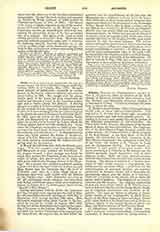

Joliet (OR JOLLIET), Louis, discoverer, the son of a wagon-maker, was born at Quebec, Canada, on September 21, 1645; d. in Canada, May, 1700. He gave great promise of scholarship, especially in mathematics, in the Jesuits’ school at Quebec, and received minor orders in 1662. But, caught with the adventurous spirit of the times, he early abandoned his studies and became a rover in the Canadian wilderness and a trader among the Indians. A fleeting glimpse is caught of Joliet searching for a copper mine on the borders of Lake Superior, in 1669; and again, in 1671, he is seen standing by the side of Saint-Lusson as he plants the arms of France at Sault Sainte Marie. In 1672, upon the advice of the intendant, Talon, Joliet was dispatched by Governor Frontenac to explore the grande riviere beyond the Lakes, which the Indians alleged flowed into the southern sea. In the order the French governor refers to Joliet as one “experienced in these kinds of discoveries and who had been already very near the river”. In December of the same year Joliet reached the Straits of Mackinaw, where, with Pere Marquette, he spent the winter and the early spring in questioning the Indians and preparing maps for the journey.
In May of the following year, 1673, the historic quest began. With five voyageurs and two canoes, Joliet and Marquette in June reached the Fox River. A few leagues beyond, a short portage was found by which they reached the Wisconsin, down the tortuous course of which they glided until, on June 17, the little party drifted into the great waters of the Mississippi. For a month they paddled southward, passing a great river from the west which the Indians assured them flowed into the Vermeille Sea—the Gulf of California—and, near it, a little village whose inhabitants, they were told, traded with the Indians on the Pacific coast. Joliet descended the river to 30° 40′, christening rivers, plateaus, and elevations with Indian and French names which were destined to endure no longer than La Salle’s great dream of the “Empire of New France“.
Having established beyond doubt the important fact that the great river emptied into the Gulf of Mexico, the expedition returned, arriving at Green Bay in September, after having paddled 2500 miles. Here Marquette remained while Joliet hurried to Quebec, where he arrived the middle of August, 1674, after having lost all his documents and maps by the upsetting of his canoe in the Lachine Rapids. Whether or not Joliet was the first Frenchman to have gazed upon the Great River, the reports that he laid before the governor and his establishment of the fact that the Mississippi was a highway to the sea led to the immediate formation of plans on the part of Canadian merchants and officers for the settlement of the Mississippi Valley, though Joliet’s offer to plant a colony among the Illinois was refused by the French Government. Shortly after his return Joliet was married to Claire-Francoise Bissot. In 1680 he was granted the Island of Anticosti, where he erected a fort, which was subsequently captured by the English in 1690, upon which occasion his wife was taken prisoner. The restless spirit of the explorer persevered in Joliet to the end, for mention is made, within a few years of his death, of extensive wanderings in Labrador. In 1693 he was appointed royal hydrographer, and, on April 30, 1697, he was granted the seigniory of Joliet, south of Quebec, which is still in the possession of his descendants. He died in Canada in May, 1700, one of the first native Americans to have achieved historical distinction.
JARVIS KEILEY

